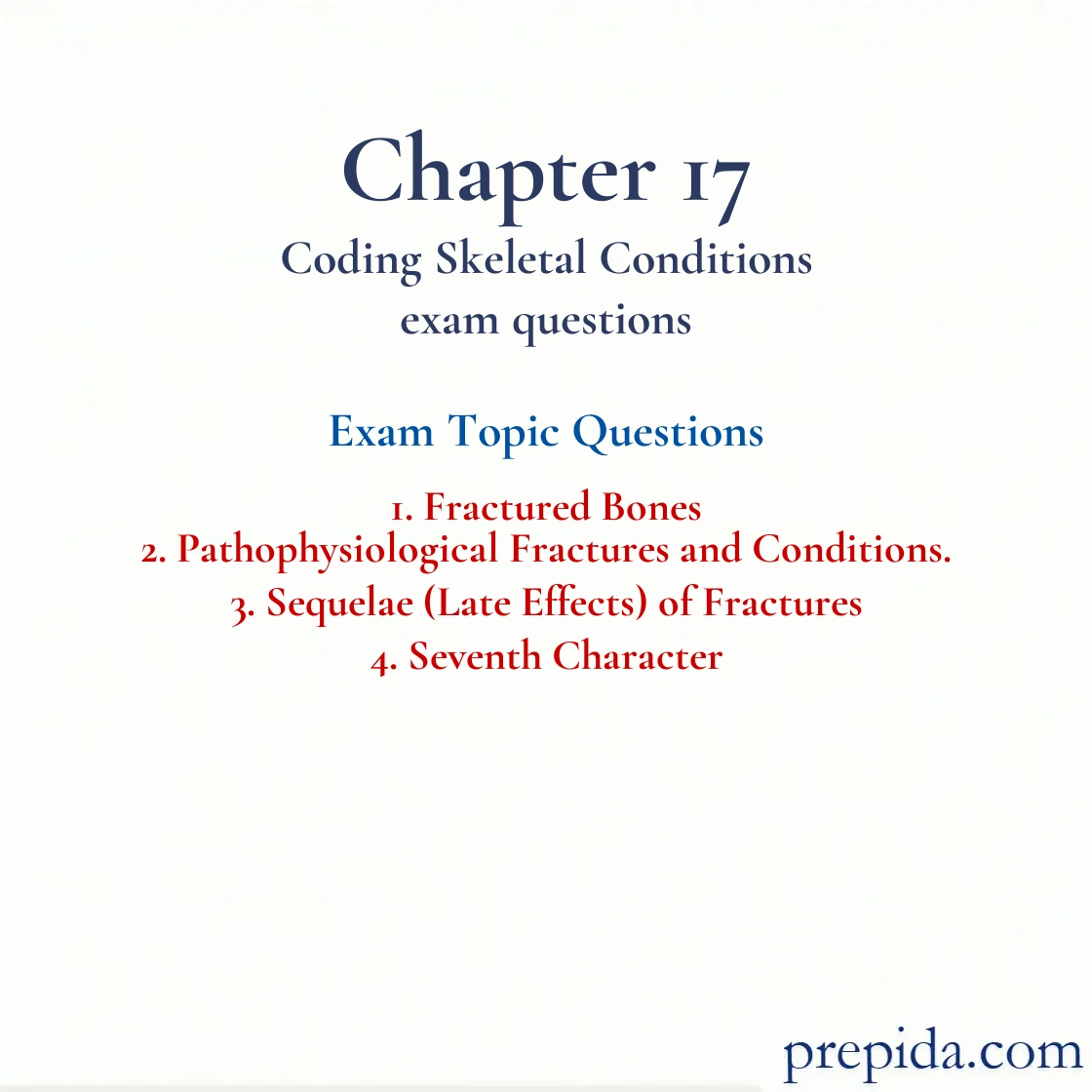
Which of the following types of fractures identifies the breaking of the bone into several pieces?
- Avulsion
- Burst
- Comminuted
- Depressed
A comminuted fracture happens when the bone breaks into several pieces.
Fracture: Broken cartilage or bone.
Which of the following types of fractures happens when a tiny bone piece breaks off at the point where a ligament or tendon attaches to the bone?
- Avulsion
- Burst
- Comminuted
- Depressed
An avulsion fracture happens when a tiny bone piece breaks off at the point where a ligament or tendon attaches to the bone.
Fracture: Broken cartilage or bone.
Which of the following types of fractures is typically caused by a severe blow to the eye?
- Basal skull
- Blowout
- Depressed skull
- Stellate
A blowout fracture is typically caused by a severe blow to the eye.
Fracture: Broken cartilage or bone.
What is the correct code for a displaced oblique fracture to the shaft of the left tibia, initial encounter?
- S82.231D
- S82.222A
- S82.232A
- S82.242G
The correct code for a displaced oblique fracture to the shaft of the left tibia, initial encounter, is S82.232A. S82.232A: Index>fracture>tibia>oblique>displaced>left>initial encounter.
Which of the following types of fractures is a fracture of the epiphyseal plate?
- Fissured
- Impacted
- Oblique
- Salter-Harris
A Salter-Harris fracture is a fracture of the epiphyseal plate.
Which of the following types of fractures happens when the bone has been placed inward?
- Avulsion
- Burst
- Comminuted
- Depressed
A depressed fracture happens when the bone has been placed inward.
Which of the following types of fractures happens when a vertebra has been crushed in all directions?
- Avulsion
- Burst
- Comminuted
- Depressed
A burst fracture happens when a vertebra has been crushed in all directions.
Burn: Injury by heat, fire, or a chemical.
What is the correct code for localized osteoporosis?
- M81.0
- M81.6
- M81.8
- M83.0
The correct code for a patient with localized osteoporosis is M81.6. M81.6: Index>osteoporosis>localized.
Diagnosis: A physician’s determination of a patient’s condition, illness, or injury.
What is the correct code for spina bifida, lumbar?
- Q05.3
- Q05.5
- Q05.7
- Q05.9
The correct code for spina bifida, lumbar, is Q05.7. Q05.7: Index>spina bifida>lumbar.
Diagnosis: A physician’s determination of a patient’s condition, illness, or injury.
What is the correct code for a patient seen for a sequela for a torus fracture of the lower end of the right ulna?
- S52.621A
- S52.621D
- S52.621G
- S52.621S
The correct code for a patient seen for a sequela for a torus fracture of the lower end of the right ulna is S52.621S. S52.621S: Index>fracture>ulna>lower end>torus>right>sequela.
What is the correct code for a patient seen for malunion of a displaced fracture of the coronoid process of the right ulna?
- S52.041A
- S52.041D
- S52.041G
- S52.041P
The correct code for a patient seen for malunion of a displaced fracture of the coronoid process of the right ulna is S52.041P. S52.041P: Index>fracture>ulna>upper end>coronoid process>right>subsequent encounter for fracture with malunion.
What is the correct code for a patient being seen for delayed healing of a Le Fort III fracture?
- S02.413A
- S02.413B
- S02.413D
- S02.413G
The correct code for a patient being seen for delayed healing of a Le Fort III fracture is S02.413G. S02.413G: Index>fracture>maxilla>Le Fort III>subsequent encounter for fracture with delayed healing.
Which of the following seventh characters is used to show that the patient was seen for an initial encounter for treatment of a fracture?
- A
- D
- G
- K
The seventh character A is used to show that the patient was seen for an initial encounter for treatment of a fracture.
Which of the following seventh characters is used to show that the patient was seen to check for healing of a fracture?
- A
- D
- G
- K
The seventh character D is used to show that the patient was seen to check for healing of a fracture.